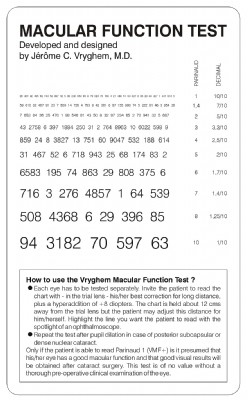What is the Macular Function Test?
This test of the Macular Function has been created by Dr J.C. Vryghem in 1993. The test is used during a preoperative appointment to assess the visual result that will be obtained after a cataract surgery.

Potential vision tests before cataract surgery are essential to determine if surgery will produce visual improvements for the patient. The primary function of potential vision tests is to establish whether cataract is the only cause of visual impairment. If a patient is affected with retinal or corneal pathologies, visual recovery after phacoemulsification may be poor.
There are several methods to test potential vision. Retinal acuity may be predicted with tests including electroretinograpy,1-3 visual evoked potentials,1,2,4,5 color vision tests,6 blue-field entoptic tests,7-9 and B-scan ultrasonography.2 Other tests, which are discussed in this article round-up, include potential acuity meter assessment, retinal acuity meter assessment, and critical flicker/fusion frequency.
In the past, some potential vision test methods employed entoptic phenomena, however, these were not sensitive enough to distinguish the degree of visual impairment. Since 1993, I have used an inexpensive method of potential visual acuity measurement, which I named the Vryghem Macular Function Test. We found this method to boast a 94.2% sensitivity and a 32.4% specificity. This test also had a positive predictive value of 99.2%, a negative predictive value of 24.3%, and a BCVA of 20/30.
The only tools needed for the test are a Parinaud near reading chart (Figure 1), a trial lens of 8.00 D, and a Heine ophthalmoscope (Heine Optotechnik, Herrsching, Germany). The test is easy to conduct. First, position the Parinaud optotype letter chart approximately 12 cm from the trial lens, with the best correction for long distances and a hyperaddition of 8.00 D in the trial frame. Then, ask the patient to read the letter chart while illuminating the lines with a Heine ophthalmoscope.
The distance from the chart to the patient’s eyes is important, and patients should move the chart themselves. Ask them to read the smallest numbers on the chart (grade Parinaud 1). Those who can read this line are given a positive score, as it is assumed that their macular function is good. Those who cannot read the smallest numbers on the chart should receive a negative score, indicating that their macular function is bad or beyond evaluation. In these patients, it is likely that their BCVA would be worse than 20/30.
We routinely use the Vryghem Macular Function Test preoperatively, during our clinical evaluation of a cataract patient. We base our decision to proceed with surgery on the outcome of the macular function test as well as the clinical evaluation, which includes cataract grading, distance BCVA, slit-lamp evaluation, applanation tonometry, and fundoscopy. If patients have posterior subcapsular plaque or a dense nuclear cataract, the test can be repeated after dilation of their pupils with phenylephrine 15% and tropicamide.
From September 2000 to February 2001, we conducted a prospective study of 396 patients (128 male and 268 female) in whom I performed cataract surgery. 10 Of these patients, 37 were not able to read Parinaud 1 before surgery. Of the 359 patients (90.75%) who could read Parinaud 1, 94.2% had a postoperative BCVA of 20/25 or better and 99.2% had a BCVA of 20/30 or better, which was the positive predictive value of the test. Of patients who could not read Parinaud 1, 67.6% and 75.7% had a postoperative BCVA of 20/35 and 20/30 or better, respectively. Thus, the respective negative predictive values were 32.4% and 24.3%. The Vryghem Macular Function Test yielded a high positive predictive value and sensitivity, but a low specificity and negative predictive value. Of the 25 patients who could not read Parinaud 1, but attained a postoperative BCVA of 20/25 or better, 18 had a nuclear or subcapsular cataract of a density that made it impossible to read that line.
We concluded that the Vryghem Macular Function Test is 99.2% accurate. If the test proves positive, the surgeon may assume that the patient’s macular function is adequate, which indicates that good visual outcomes will result after cataract surgery. If the result is negative—indicating poor macular function—the chance of good visual outcome after cataract surgery fades. In these cases, a final BCVA of 20/30 or better is highly unlikely.